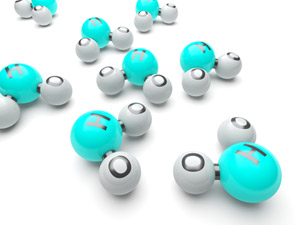
- The TRUTH About America's Water
- Water Pollutants that Cause Illness
- Are Minerals in Water Important for Health?
- Top 5 Drinking Water Contaminants
- Do I Need a Whole House Water Filter?
Introduction to Water Chemistry
Based on the discoveries of our satellites, it appears that water is a unique substance in our discovered universe. The presence of water on earth is in itself unique, for the planet earth has few natural liquids. Water is the prime resource of man's food supply and his most important household and industrial tool. But most important is the fact that water is a major constituent of all living matter, comprising up to two-thirds of the human body. Next to the air, we breathe, water is mankind's most important substance.
PHYSICAL AND CHEMICAL CHANGES
Physical change — A physical change is one in which there is no change in the molecules that make up a given substance. Turning water into ice or vapor does not constitute a chemical change because the same molecules make up the liquid, solid, and vapor states of water. The only difference between ice, steam, and water is this: molecules in ice essentially have no freedom. The only vibrate within the crystal. The molecules in water are free to move within the limits of the container, as limited by gravity. The molecules in the stream are completely free to move within the container if any. They are essentially unaffected by gravity.
Chemical change — A chemical change occurs when new molecules are formed as a result of the change.
When water turns to steam at 212°F, a physical change occurs. On the other hand, when propane gas is ignited, it turns to carbon dioxide and water vapor in a chemical change. And change, of course, continues all the time. Let's briefly consider the types of change by examining the compounds and mixtures.

COMPOUNDS AND MIXTURES
How can one distinguish between compounds and mixtures? A compound has a definite and unvarying composition.
Water is a typical compound. It is composed of two elements hydrogen and oxygen in definite proportions. Regardless of where one gets water, it always consists of these two elements and is always in the same proportion. Salt is another common compound. Whether it comes from a salt mine or is produced in a laboratory, salt is a compound of the two elements sodium and chlorine in an unvarying ratio.
Water, as a typical compound, also suggests another characteristic of the compound, namely a unique "personality" of its own. Although made up of hydrogen and oxygen, water is quite different from these two elements both physically and chemically. And so we should add to our definitions: a compound has well-defined characteristics of its own, usually entirely different from those of its component elements.
Further, water freezes at 32°F and boils at 212°F. This indicates another characteristic of the compound: a pure compound has a definite freezing and a definite boiling point.
And finally, water, as a typical compound, is a uniform substance no matter whether one is considering a drop, a glassful, or a lake of it. Thus, a compound is homogeneous*.
In sharp contrast, a mixture will vary in the number of ingredients it contains. A mixture of sand and salt, for example, may have a bit of salt and a large amount of sand. Or it may be a blend of a large amount of salt and sand. No exact ratios of substances are necessary to constitute a mixture. At the same, the ingredients in a mixture continue to maintain their essential properties. The salt still tastes salty; the sand continues to be gritty. The properties of the mixture are simply the total of the separate properties of the salt and sand. In this salt sand mixture, the original ingredients could be recovered through some type of mechanical process. And finally, a mixture may have varying proportions of its ingredients in different parts of the sample. There may be more salt than sand at the bottom and less at the top of a mixture. In a word, mixtures are usually heterogeneous**.
* Homogeneous. A substance that is uniform throughout its composition is said to be homogeneous. For example, homogenized milk is homogeneous because the globules of fat have been broken down into smaller sizes and have been distributed throughout the liquid.
** Heterogeneous. A mixture which is not uniform throughout is said to be heterogeneous. Unhomogenized milk may contain large globules of fat which can separate and float to the top of the container.

